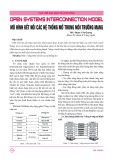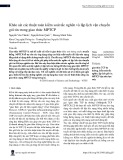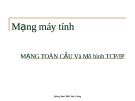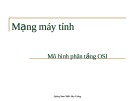Mạng máy tính nâng cao-V1
1
OSPF Overview OSPF Overview
◦ Creates a neighbor relationship by exchanging
hello packets
◦ Propagates LSAs rather than routing table
updates (cid:1) Link: Router interface (cid:1) State: Description of an interface and its relationship to
neighboring routers neighboring routers
◦ Floods LSAs to all OSPF routers in the area, not
just directly connected routers
◦ Pieces together all the LSAs generated by the OSPF routers to create the OSPF link-state database
◦ Uses the SPF algorithm to calculate the shortest
path to each destination and places it in the routing table
Example OSPF Hierarchy Example OSPF Hierarchy
(cid:1) Minimizes routing table entries (cid:1) Localizes the impact of a topology change within an area
Neighbor Adjacencies: The Hello Neighbor Adjacencies: The Hello Packet Packet
SPF Algorithm SPF Algorithm
◦ Places each router at the root of a tree and calculates the shortest path to each destination based on the cumulative cost
◦ Cost = Reference Bandwidth / Interface Bandwidth (b/s)
Area OSPF Configuring Single--Area OSPF Configuring Single
RouterX(config)#
router ospf process-id (cid:1) Defines OSPF as the IP routing protocol
RouterX(config-router)#
network address wildcard-mask area area-id (cid:1) Assigns networks to a specific OSPF area (cid:1) Assigns networks to a specific OSPF area
Configuring Loopback Interfaces Configuring Loopback Interfaces
Router ID: (cid:1) Number by which the router is known to OSPF (cid:1) Default: The highest IP address on an active interface at the moment of
OSPF process startup
(cid:1) Can be overridden by a loopback interface: Highest IP address of any active
loopback interface
(cid:1) Can be set manually using the router-id command
Verifying the OSPF Configuration Verifying the OSPF Configuration
RouterX# show ip protocols (cid:1) Verifies that OSPF is configured
RouterX# show ip route (cid:1) Displays all the routes learned by the router
RouterX# show ip route
Codes: I - IGRP derived, R - RIP derived, O - OSPF derived, C - connected, S - static, E - EGP derived, B - BGP derived, E2 - OSPF external type 2 route, N1 - OSPF NSSA external type 1 route, N2 - OSPF NSSA external type 2 route
Gateway of last resort is 10.119.254.240 to network 10.140.0.0
O 10.110.0.0 [110/5] via 10.119.254.6, 0:01:00, Ethernet2 O IA 10.67.10.0 [110/10] via 10.119.254.244, 0:02:22, Ethernet2 O 10.68.132.0 [110/5] via 10.119.254.6, 0:00:59, Ethernet2 O 10.130.0.0 [110/5] via 10.119.254.6, 0:00:59, Ethernet2 O E2 10.128.0.0 [170/10] via 10.119.254.244, 0:02:22, Ethernet2 . . .
Verifying the OSPF Configuration Verifying the OSPF Configuration (Cont.) (Cont.)
RouterX# show ip ospf (cid:1) Displays the OSPF router ID, timers, and statistics
RouterX# show ip ospf Routing Process "ospf 50" with ID 10.64.0.2 Routing Process "ospf 50" with ID 10.64.0.2
Number of areas in this router is 1. 1 normal 0 stub 0 nssa Number of areas transit capable is 0 External flood list length 0 Area BACKBONE(0) Area BACKBONE(0)
Area has no authentication SPF algorithm last executed 00:01:25.028 ago SPF algorithm executed 7 times
Verifying the OSPF Configuration Verifying the OSPF Configuration (Cont.) (Cont.)
RouterX# show ip ospf interface (cid:1) Displays the area ID and adjacency information
RouterX# show ip ospf interface ethernet 0/0
Ethernet0/0 is up, line protocol is up
Internet Address 192.168.1.2/24, Area 24 Process ID 201, Router ID 192.168.1.2, Network Type BROADCAST, Cost: 10 Transmit Delay is 1 sec, State DR, Priority 255 Transmit Delay is 1 sec, State DR, Priority 255 Designated Router (ID) 192.168.1.2, Interface address 192.168.1.2 Backup Designated router (ID) 4.4.4.4, Interface address 192.168.1.4 Timer intervals configured, Hello 10, Dead 40, Wait 40, Retransmit 5
oob-resync timeout 40 Hello due in 00:00:08
Supports Link-local Signaling (LLS) Cisco NSF helper support enabled IETF NSF helper support enabled Index 1/3, flood queue length 0 Next 0x0(0)/0x0(0) Last flood scan length is 2, maximum is 2 Last flood scan time is 0 msec, maximum is 0 msec Neighbor Count is 1, Adjacent neighbor count is 1
Adjacent with neighbor 4.4.4.4 (Backup Designated Router
Suppress hello for 0 neighbor(s)
Verifying the OSPF Configuration Verifying the OSPF Configuration (Cont.) (Cont.)
RouterX# show ip ospf neighbor (cid:1) Displays the OSPF neighbor information on a per-interface basis
RouterX# show ip ospf neighbor
ID ID 10.199.199.137 172.16.48.1 172.16.48.200 10.199.199.137 Pri State Dead Time Address Interface Pri State Dead Time Address Interface 1 FULL/DR 0:00:31 192.168.80.37 FastEthernet0/0 1 FULL/DROTHER 0:00:33 172.16.48.1 FastEthernet0/1 1 FULL/DROTHER 0:00:33 172.16.48.200 FastEthernet0/1 5 FULL/DR 0:00:33 172.16.48.189 FastEthernet0/1
Verifying the OSPF Configuration Verifying the OSPF Configuration (Cont.) (Cont.)
RouterX# show ip ospf neighbor 10.199.199.137 Neighbor 10.199.199.137, interface address 192.168.80.37 In the area 0.0.0.0 via interface Ethernet0 Neighbor priority is 1, State is FULL Options 2 Options 2 Dead timer due in 0:00:32 Link State retransmission due in 0:00:04 Neighbor 10.199.199.137, interface address 172.16.48.189 In the area 0.0.0.0 via interface Fddi0 Neighbor priority is 5, State is FULL Options 2 Dead timer due in 0:00:32 Link State retransmission due in 0:00:03
OSPF debug Commands OSPF debug Commands
RouterX# debug ip ospf events
OSPF:hello with invalid timers on interface Ethernet0 hello interval received 10 configured 10 net mask received 255.255.255.0 configured 255.255.255.0 net mask received 255.255.255.0 configured 255.255.255.0 dead interval received 40 configured 30
OSPF: rcv. v:2 t:1 l:48 rid:200.0.0.117 aid:0.0.0.0 chk:6AB2 aut:0 auk:
RouterX# debug ip ospf packet
OSPF: rcv. v:2 t:1 l:48 rid:200.0.0.116
aid:0.0.0.0 chk:0 aut:2 keyid:1 seq:0x0
Load Balancing with OSPF Load Balancing with OSPF
(cid:2) OSPF load balancing:
◦ Paths must be equal cost ◦ By default, up to four equal-cost paths can
be placed into the routing table
◦ With a configuration change, up to a ◦ With a configuration change, up to a
maximum of 16 paths can be configured: (cid:1) (config-router)# maximum-paths
◦ To ensure paths are equal cost for load
balancing, you can change the cost of a
particular link:
(cid:1) (config-if)# ip ospf cost
Load Balancing with OSPF Load Balancing with OSPF (Cont.) (Cont.)
OSPF Authentication OSPF Authentication
◦ OSPF supports the following types of authentication:
(cid:1) Null (no authentication) (cid:1) Plaintext (or simple) password authentication (cid:1) MD5 authentication
◦ The router generates and checks every OSPF packet. ◦ The router generates and checks every OSPF packet. ◦ The router authenticates the source of each routing
update packet that it receives.
◦ Configure a “key” (password); each participating neighbor must have the same key configured.
Configuring OSPF Plaintext Configuring OSPF Plaintext Password Authentication Password Authentication
RouterX(config-if)#
ip ospf authentication-key password (cid:1) Assigns a password to use with neighboring routers
RouterX(config-if)#
ip ospf authentication [message-digest | null] ip ospf authentication [message-digest | null] (cid:1) Specifies the authentication type for an interface (as of Cisco
IOS Release 12.0)
OR
RouterX(config-router)#
area area-id authentication [message-digest] (cid:1) Specifies the authentication type for an area
Plaintext Password Plaintext Password Authentication Configuration Authentication Configuration Example Example
Verifying Plaintext Password Verifying Plaintext Password Authentication Authentication
RouterX#show ip ospf neighbor Neighbor ID Pri State Dead Time Address Interface 10.2.2.2 0 FULL/ - 00:00:32 192.168.1.102 Serial0/0/1
RouterX#show ip route
10.0.0.0/8 is variably subnetted, 2 subnets, 2 masks
O 10.2.2.2/32 [110/782] via 192.168.1.102, 00:01:17, Serial0/0/1 C 10.1.1.0/24 is directly connected, Loopback0
192.168.1.0/27 is subnetted, 1 subnets
C 192.168.1.96 is directly connected, Serial0/0/1
RouterX#ping 10.2.2.2 Type escape sequence to abort. Sending 5, 100-byte ICMP Echos to 10.2.2.2, timeout is 2 seconds: !!!!! Success rate is 100 percent (5/5), round-trip min/avg/max = 28/29/32 ms
Visual Objective 4--1: 1: Visual Objective 4 Implementing OSPF Implementing OSPF
Summary Summary
◦ OSPF is a classless, link-state routing protocol that uses an area
hierarchy for fast convergence.
◦ OSPF exchanges hello packets to establish neighbor adjacencies
between routers.
◦ The SPF algorithm uses a cost metric to determine the best path.
Lower costs indicate a better path.
◦ The router ospf process-id command is used to enable OSPF on
the router. the router.
◦ Use a loopback interface to keep the OSPF router ID consistent. ◦ The show ip ospf neighbor command displays OSPF neighbor
information on a per-interface basis.
◦ The commands debug ip ospf events and debug ip ospf packets
can be used to troubleshoot OSPF problems.
◦ OSPF will load-balance across up to four equal-cost metric paths by
default.
◦ There are two types of OSPF authentication: Plaintext and MD5.














![Câu hỏi trắc nghiệm Mạng máy tính: Tổng hợp [mới nhất]](https://cdn.tailieu.vn/images/document/thumbnail/2025/20251001/kimphuong1001/135x160/15231759305303.jpg)
![Câu hỏi ôn tập An toàn mạng môn học: Tổng hợp [mới nhất]](https://cdn.tailieu.vn/images/document/thumbnail/2025/20250919/kimphuong1001/135x160/30511758269273.jpg)






![Giáo trình Công nghệ mạng không dây (Nghề Quản trị mạng máy tính, Trình độ Cao đẳng) - Trường Cao đẳng Thủ Thiêm [Mới nhất]](https://cdn.tailieu.vn/images/document/thumbnail/2025/20250916/kimphuong1001/135x160/13561758013095.jpg)



